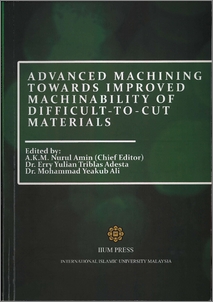Amin, A. K. M. Nurul and Nashron, F. R. and Zubaire, W. W. D.
(2011)
Role of the frequency of secondary serrated teeth in chatter formation during turning of carbon steel AISI 1040 and stainless steel.
In:
Advanced Machining Towards Improved Machinability of Difficult-to-Cut Materials.
IIUM Press, Kuala Lumpur, Malaysia, pp. 57-64.
ISBN 9789674181758
![[img]](http://irep.iium.edu.my/style/images/fileicons/application_pdf.png)  Preview |
|
PDF ( Role of the frequency of secondary serrated teeth in chatter formation during turning of carbon steel AISI 1040 and stainless steel)
- Published Version
Download (566kB)
| Preview
|
Abstract
High metal removal rate with a desired quality of surface finish is the ultimate objective in
machining, but it depends on a large number of factors, which include chip-tool interaction,
cutting temperature, wear mechanism and wear rate, cutting force, chatter and dynamics behavior
of the machine tool system. Chatter causes instability of the machine tool system. Though there
has been a large number of works on identifying the causes of chatter and its behavior there is
still no congruence of opinion on the causes of chatter formation and hence there is a need for
further studies to identify the physical causes of chatter so that the issue of chatter control can be
addressed more effectively. Taylor was the first to suggest that vibration during the cutting of
metals was due to force variations created by periodic shearing in chip formation [1]. In the
beginning, the question was to decide whether fluctuations during the cutting process are a result
of vibration in the system or the cutting process itself has an inherent natural periodicity. If the
latter were the case, then even with an infinitely rigid machine-tool-workpiece system, force
fluctuations and thus vibrations would be observed. Available evidence suggests that this is the
case. There are inherent features of the cutting process that make it periodic.
Among the types of inherent fluctuations in metal cutting are built-up-edge (BUE) formation,
chip segmentation, element and discontinuous chip formation. Kuznetsov [2], Shteinberg [3],
Kudinov [4], considered that the vibration caused by the BUE is responsible for chatter.
However, the natural frequencies of the system were significantly higher than the frequencies of
buolt-up-edge. Moreover it is not explained why chatter also exists at relatively higher cutting
speeds where BUE is absent. Eliasberg [5] considered that the cause of chatter is the formation of
a crack in the chip above the tool point when viewed using a video camera from the side of the
chip. However, Loladze [6] established that at higher cutting speeds, the chip fully adheres to the
tool surface. As such, there cannot be any cracks formed at the tool point at those cutting speed
ranges. Doi [7], Doi and Kato [8], and later Kato [9] and Tashlickii [10] concluded that chatter
was established primarily due to a phase lag of the cutting force with respect to the fluctuation of
chip thickness. However Smith [11] and Smith and Tobias [12] suggested that the findings by
Doi and Kato [8] and later by Tashlickii [10] found a force phase lag only because the frequency
of fluctuations was low. Tobias [13] was the first to mention about the chip-thickness variation effect i.e. the regenerative effect. He proposed that this effect occurs with single-edged tools,
such as lathe tools, when the cutting edge of the tool traverses a wavy surface on the work
generated by the previous cut. However, Amin [14] concluded based his experimental
investigations that during turning there is an inherent instability of metal cutting process as a
result of the formation of secondary serrated teeth at the free edge of the chip and that the natural
frequencies of two system components namely, the spindle-work system and the tool holder,
played significant role in exciting chatter during turning operation.
Actions (login required)
 |
View Item |


 Download Statistics
Download Statistics Download Statistics
Download Statistics